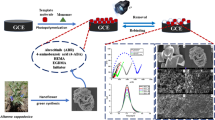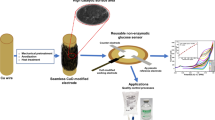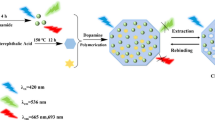Abstract
In recent years, the global emergence of antibacterial resistance has led to the development of new antibacterial drugs with unique chemical structures. The FDA has recently approved delafloxacin for acute bacterial infection treatment. The proposed potentiometric sensor is considered as the first electrochemical method for accurate, precise, and sensitive determination of delafloxacin. It was based on developing a novel polymeric material that functioned as a recognition element and a transducer at the same time. This polymeric material was fabricated by the covalent polymerization of aniline monomers with the crown ether ionophore and followed by the ionic attachment to the surface of the MWCNTs. A linear response ranging from 1 × 10–3 to 1 × 10–8 mol L−1 and a high sensitivity reached nano-molar level down to 3.5 × 10–9 mol L−1 have been displayed by the fabricated sensor. It was used efficiently in human plasma, pure form, and pharmaceutical tablets for the quantitation of delafloxacin with high recovery ranged from 97.68% to 100.45% and without any extraction or pretreatment steps. The proposed sensor is characterized by high selectivity and stability over 143 days with no surface renewal.
Graphic abstract









Similar content being viewed by others
Data availability
The data that support the findings of this study are available from the corresponding author upon request.
Code availability
Not applicable.
References
Mogle BT et al (2018) Clinical review of delafloxacin: a novel anionic fluoroquinolone. J Antimicrob Chemother 73(6):1439–1451
Scott LJ (2020) Delafloxacin: a review in acute bacterial skin and skin structure infections. Drugs 80(12):1247–1258
Dhangar KR, Shirkhedkar AA (2016) Estimation of delafloxacin using derivative spectrophotometry and area under curve in bulk material and in laboratory mixture. J Pharm Technol, Res and Manag 4(1):81–87
Alam P et al (2020) Determination of delafloxacin in pharmaceutical formulations using a green RP-HPTLC and NP-HPTLC methods: a comparative study. Antibiotics (Basel) 9(6):359–372
Iqbal, M., et al., Development and validation of a novel UPLC-MS/MS method for quantification of delafloxacin in plasma and aqueous humour for pharmacokinetic analyses. J Chromatogr B Analyt Technol Biomed Life Sci, 2020. 1138: p. 121961.
Huang M-R et al (2012) Advanced solid-contact ion selective electrode based on electrically conducting polymers. Chin J Anal Chem 40(9):1454–1460
Liang R, Yin T, Qin W (2015) A simple approach for fabricating solid-contact ion-selective electrodes using nanomaterials as transducers. Anal Chim Acta 853:291–296
Faridbod F et al (2008) Schiff’s bases and crown ethers as supramolecular sensing materials in the construction of potentiometric membrane sensors. Sensors 8:1645–1703
Ganjali MR et al (2006) Supramol Based Membrane Sensors Sensors 6:1018–1086
Le TH, Kim Y, Yoon H (2017) Electrical and electrochemical properties of conducting polymers. Polymers (Basel) 9(4):150–181
Elnaggar EM et al (2017) Comparative study on doping of polyaniline with graphene and multi-walled carbon nanotubes. J Nanostructure Chem 7(1):75–83
El-Rahman MKA et al (2015) Design of a stable solid-contact ion-selective electrode based on polyaniline nanoparticles as ion-to-electron transducer for application in process analytical technology as a real-time analyzer. Sens Actuators, B Chem 208:14–21
Kamel AH et al (2019) Novel solid-state potentiometric sensors using polyaniline (PANI) as a solid-contact transducer for flucarbazone herbicide assessment. Polymers (Basel) 11:1796–1806
Malhotra B et al (2015) Polyaniline-based biosensors Nanobiosensors in Disease Diagnosis 4:25–46
Zengin H et al (2002) Carbon nanotube doped polyaniline. Adv Mater 14:1480–1483
Gan T et al (2016) Highly sensitive and molecular selective electrochemical sensing of 6-benzylaminopurine with multiwall carbon nanotube@SnS2-assisted signal amplification. J Appl Electrochem 46(3):389–401
Saleh Ahammad AJ, Lee JJ, Rahman MA (2009) Electrochemical sensors based on carbon nanotubes. Sensors (Basel) 9(4):2289–2319
Dhand C et al (2008) Preparation of polyaniline/multiwalled carbon nanotube composite by novel electrophoretic route. Carbon 46(13):1727–1735
Dhand C et al (2008) Polyaniline-carbon nanotube composite film for cholesterol biosensor. Anal Biochem 383(2):194–199
Cui L et al (2013) Doped polyaniline/multiwalled carbon nanotube composites: Preparation and characterization. Polym Compos 34(7):1119–1125
Huang Y (2019) Synthesis and application of MnO2/PANI/MWCNT ternary nanocomposite as an electrode material for supercapacitors. Int J Electrochem Sci. https://doi.org/10.20964/2019.09.86
Nikzad L, Vaezi MR, Yazdani B (2012) Synthesis of carbon nanotube–Poly aniline nano composite and evaluation of electrochemical properties. Int J Modern Phys: Conference Series 05:527–535
Oueiny C, Berlioz S, Perrin F-X (2014) Carbon nanotube–polyaniline composites. Prog Polym Sci 39(4):707–748
Wu T-M, Lin Y-W (2006) Doped polyaniline/multi-walled carbon nanotube composites: preparation, characterization and properties. Polymer 47(10):3576–3582
Pandharipande S, Bankar SS (2017) Development of polyaniline grafted chitosan sensor for detection of ammonia & ethanol vapour. Int Res J Eng and Technol 4(8):534–540
Hussain T et al (2018) Polyaniline/silver decorated-MWCNT composites with enhanced electrical and thermal properties. Polym Compos 39(S3):E1346–E1353
Evtugyn GA et al (2010) Discrimination of apple juice and herbal liqueur brands with solid-state electrodes covered with polyaniline and thiacalixarenes. Talanta 82(2):613–619
Evtugyn GA et al (2007) Ag selective electrode based on glassy carbon electrode covered with polyaniline and thiacalix[4]arene as neutral carrier. Talanta 71(4):1720–1727
Mahmoud AM et al (2015) Carbon nanotubes versus polyaniline nanoparticles; which transducer offers more opportunities for designing a stable solid contact ion-selective electrode. J Electroanal Chem 755:122–126
Soleymanpour A, Rezvani SA (2017) Liquid membrane/polyaniline film coated glassy carbon sensor for highly sensitive and selective determination of fluvoxamine in pharmaceutical and biological samples. Sens Actuators, B Chem 247:602–608
G, M., R.J. Mascarenhas, and B.M. Basavaraja, (2019) Sensitively-selective determination of Propyl Paraben preservative based on synergistic effects of polyaniline-zinc-oxide nano-composite incorporated into graphite paste electrode. Colloids Surf B Biointerfaces 184:e110529
Tawade AK et al (2019) Flower-like ZnO-decorated polyaniline-graphene oxide nanocomposite for electrochemical oxidation of imidacloprid: a hybrid nanocomposite sensor. J Electron Mater 48(12):7747–7755
Wang A-J et al (2010) In-situ decorated gold nanoparticles on polyaniline with enhanced electrocatalysis toward dopamine. Microchim Acta 171(3–4):431–436
Zahed FM et al (2018) Silver nanoparticles decorated polyaniline nanocomposite based electrochemical sensor for the determination of anticancer drug 5-fluorouracil. J Pharm Biomed Anal 161:12–19
Dhall, S., Cost effective synthesis of MWCNTs/PANI composites. Materials Research Express, 2016. 3(10): p. 105002.
Thakur, V.K. and M.K. Thakur, Chemical Functionalization of Carbon Nanomaterials Chemistry and Applications. 2016: CRC Press Taylor & Francis Group.
Umezawa Y et al (2000) Potentiometric selectivity coefficients of ion-selective electrodes. Part I inorganic cations (technical report). Pure and Appl Chem 72(10):1851–2082
Abdallah NA (2020) Solid-contact ISE for the potentiometric determination of melitracen hydrochloride in pharmaceutical tablets and human plasma. J The Electrochem Soc 167(4):e047504
Umezawa Y et al (2000) Potentiometric selectivity coefficients of ion-selective electrodes part I. Inorganic Cations Pure and Appl Chem 72(10):1851–2082
Bakker E, Pretsch E, P. Buhlmann, (2000) Selectivity of potentiometric ion sensors. Anal Chem 72:1127–1133
Umezawa Y, Umezawa K, Sato H (1995) Selectivity coefficients for ion-selective electrodes: recommended methods for reporting K pot values. Pure Appl Chem 67(3):507–518
Funding
This research did not receive any specific grant from funding agencies in the public, commercial, or not-for-profit sectors.
Author information
Authors and Affiliations
Corresponding author
Ethics declarations
Conflicts of interest
There is no conflict of interest to declare.
Additional information
Publisher's Note
Springer Nature remains neutral with regard to jurisdictional claims in published maps and institutional affiliations.
Rights and permissions
About this article
Cite this article
Abdallah, N.A., Alahmadi, Y.M., Bafail, R. et al. Multi-walled carbon nanotubes/polyaniline covalently attached 18-crown-6-ether as a polymeric material for the potentiometric determination of delafloxacin. J Appl Electrochem 52, 311–323 (2022). https://doi.org/10.1007/s10800-021-01636-z
Received:
Accepted:
Published:
Issue Date:
DOI: https://doi.org/10.1007/s10800-021-01636-z




